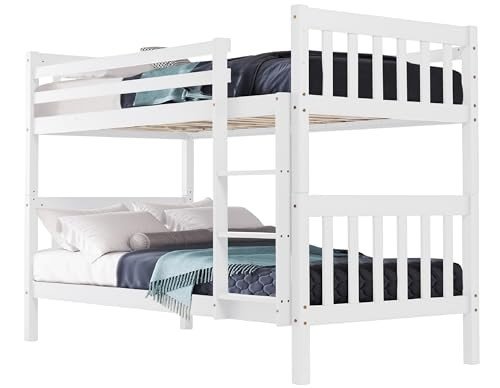15 Unquestionably Reasons To Love Bunk Beds
Exploring Bunk Beds: A Comprehensive Guide
Bunk beds have long been a staple in children's bedrooms, dormitories, and even homes with minimal space. Not just do they provide a useful sleeping service, however they likewise develop an enjoyable and imaginative environment for children and a great space-saver for adults and households. This post will explore whatever you need to know about bunk beds, from types and materials to security ideas and purchasing advice.
Table of Contents
- Kinds Of Bunk Beds
- Standard Bunk Beds
- Loft Beds
- Triple Bunk Beds
- L-Shaped Bunk Beds
- Material Options
- Wood
- Metal
- Safety Considerations
- Purchasing Guide
- FAQs
Types of Bunk Beds
Bunk beds can be found in different styles to suit different requirements and preferences. Here's a breakdown of the most typical types:
Conventional Bunk Beds
Traditional bunks typically include 2 beds stacked vertically on top of one another. These beds are ideal for brother or sisters sharing a space or for optimizing sleeping space in guest rooms.
Loft Beds
Loft beds stand likewise to conventional bunk beds but do not have a lower sleeping area. Instead, they frequently incorporate a desk or seating area underneath, making them a great choice for small spaces needing multifunctionality.
Triple Bunk Beds
Triple bunk beds are created for three occupants, with beds stacked in a three-tier configuration. These are less typical however can be an enjoyable service for large households or pajama parties.
L-Shaped Bunk Beds
With one bed positioned horizontally and the other vertically, L-shaped bunk beds are often geared up with extra functions such as desks or storage drawers and can complement corner areas in a room.
Contrast of Bunk Bed Types
Bed Type
Suitable Use
Description
Standard
Shared bedrooms or guest spaces
2 beds stacked vertically
Loft
Little spaces needing multi-purpose space
Upper bed with open space below
Triple
Big households or slumber parties
3 beds stacked vertically
L-Shaped
Corner or flexible spaces
A mix of vertical and horizontal beds
Product Options
Bunk beds are produced from various products, with wood and metal being the most common. Each material has its benefits and drawbacks.
Wood
- Sturdiness: Generally robust and can endure years of use.
- Aesthetic Appeal: Offers a timeless look that can mix with different decorations.
- Weight Capacity: Typically stronger; can support much heavier weights.
- Disadvantages: May be more costly than metal alternatives and can be vulnerable to scratches.
Metal
- Durability: Generally lightweight and simple to move but still durable.
- Modern Design: Often can be found in sleek designs, making it appealing for contemporary areas.
- Economical: Usually more economical than wooden choices.
- Disadvantages: Can be cold to the touch in winters and may not have the exact same aesthetic appeal for some purchasers.
Safety Considerations
When it concerns bunk beds, safety can not be ignored. Here are essential safety tips to keep in mind:
- Guardrails: Ensure that the leading bunk has guardrails on both sides to prevent falls.
- Strong Construction: Check for a solid construct and tough materials to hold up against weight and movement.
- Weight Limit: Adhere to the producer's weight limitation for both the upper and lower bunks.
- Ladder Design: Choose bunks with a safe, easy-to-climb ladder and avoid any sharp edges or rungs.
- Age Restrictions: Most makers suggest that children under the age of 6 ought to not oversleep the upper bunk.
Buying Guide
When searching for bunk beds, think about the list below factors to find the best suitable for your requirements:
- Space Availability: Measure the room size and ceiling height, making sure there is adequate space for the top bunk.
- Bed Size: Decide between twin, full, or larger sizes based on your requirements and the size of the space.
- Style Preference: Consider the general design of the bed room to find a suitable design.
- Ease of Setup: Look for a bunk bed that is simple to assemble.
- Budget: Bunk beds can be found in different cost ranges, so identify a spending plan before beginning your search.
Frequently asked questions
1. What is the recommended age for children to sleep on the top bunk?
Children aged 6 and older are typically recommended to sleep on the leading bunk to reduce the danger of falls.
2. How can I make my bunk bed much safer?
To improve safety, ensure guardrails are correctly set up and examine that the bed is put on a flat surface. Furthermore, encourage kids to use the ladder carefully.
3. Can ericayork.top convert a bunk bed into two different beds?
Lots of bunk beds are created to be convertible. Check the maker's specs for convertibility features.
4. What accessories are available for bunk beds?
Common accessories include bed linens, storage drawers, staircases rather of ladders, and tented canopies for a fun visual appeal.
5. How do I preserve my bunk bed?
Routine look for loose screws or structural stability can assist guarantee security. Dust the bed frequently and clean spills promptly to keep the products in good condition.
Bunk beds are versatile and a space-efficient option for numerous living situations, from kids's rooms to visitor lodgings. With lots of designs and materials available, possible purchasers have a wealth of options to think about, ensuring a combination of usefulness and visual appeals. By focusing on safety and following the pointers outlined in this guide, individuals can find the right bunk bed that suits their space and way of life, all while creating an enjoyable sleeping environment.
